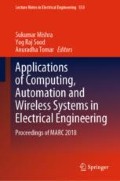Abstract
We are aware of the scenario of the twenty-first century where each and every nation of the world wants to progress at a rapid rate, weaker nations are destabilized by adopting policies like state-sponsored terrorism and online hacking which are part of the government official agenda. In this situation, there is strong need for policies to prevent data from online hacking and cyber mugging. Every nation wants to secure its data in terms of future plans, satellite images, new military setups, new river linkage plans, etc. Here, we have developed a new model advanced private content-based image retrieval (APCBIR) of data privacy based on content-based image query and retrieval (CBIQ/R). In this approach, data is smartly encrypted with only 10% of the original data, features of the original and newly encrypted images are matched by statistical parameters, and finally, the transmission of the data is done in a manner so that no one is able to reveal the identity of the original data. The efficiency of this system becomes more effective as IoT is attached to the model; data of usefulness is automatically selected and encrypted accordingly. Finally, the data gets secured from various types of malware attacks.
Access this chapter
Tax calculation will be finalised at checkout
Purchases are for personal use only
References
Gilbert K, Stephenson P (2013) Investigating computer-related crime, 2nd edn. Taylor and Francis Group, Boca Raton
Times of India. Over half a million Indian Facebook users may have been affected in data breach
The New York Times. Russian hacking and influence in the U.S. election
Dinstein Y (2012) The principle of distinction and cyber war in international armed conflicts. J Confl Secur Law 17(2):261–277
Gervais M (2012) Cyber attacks and the laws of war. Berkeley J Int Law 30(2):525–579
Farwell J, Rohozinski R (2011) Stuxnet and the future of cyber war. Survival 53(1):23–40
Landau S (2013) Making sense from Snowden: what’s significant in the NSA surveillance revelations. IEEE Comput Reliab Soc 11(4):54–63
Hyman P (2013) Cybercrime: it’s serious but exactly how serious? Commun ACM 56(3):18–20
Thomas K, Li F, Zand A, Barrett J, Ranieri J (2017) Data breaches, phishing, or malware? Understanding the risks of stolen credentials. In: Proceedings of the 2017 ACM SIGSAC conference on computer and communications security, vol I, Dallas, Texas, USA, Nov 2017, pp 1421–1434
Ameen M, Liu J, Kwak K (2012) Security and privacy issues in wireless sensor networks for healthcare applications. J Med Syst 36(1):93–101
Akhilomen J (2013) Data mining application for cyber credit-card fraud detection system. In: Advances in data mining. Applications and theoretical aspects, vol III, London, pp 218–228
Gai K, Qiu M, Thuraisingham B (2015) Proactive attribute-based secure data schema for mobile cloud in financial industry. In: IEEE high performance computing and communications (HPCC), New York, NY, USA, pp 1332–1337
Ben-Asher N, Gonzalez C (2015) Effects of cyber security knowledge on attack detection. Comput Hum Behav 48(1):51–61
Faruki P, Bharmal A, Laxmi V, Ganmoor V, Gaur M, Conti M (2014) Android security: a survey of issues, malware penetration and defenses. IEEE Commun Surv Tutor 17(2):998–1022
Faghani M, Nguyen U (2017) Modeling the propagation of Trojan malware in online social networks. IEEE Trans Dependable Secure Comput 15:1–18
Roy S, DeLoach J, Li Y, Herndon N (2015) Experimental study with real-world data for android app security analysis using machine learning. In: ACM proceedings of the 31st annual computer security applications conference, vol I, Los Angeles, CA, USA, pp 81–90
Ahmad M, Woodhead S, Gan D (2016) Early containment of fast network worm malware. In: IEEE information and computer science (NICS), vol I, Danang, Vietnam
He D, Chan S, Guizani M (2015) Mobile application security: malware threats and defenses. IEEE Wirel Commun 22(1):138–144
Muthumanickam K, Ilavarasan E (2015) Optimization of rootkit revealing system resources—a game theoretic approach. J King Saud Univ Comput Inform Sci 27(4):386–392
Eshete B, Alhuzali A, Monshizadeh M, Porras P, Venkatakrishnan VN, Yegneswaran V (2015) EKHUNTER: a counter-offensive toolkit for exploit kit infiltration. In: NDSS internet society I, pp 1–15
Chandra J, Challa N, Pasupul S (2015) Intelligence based defense system to protect from advanced persistent threat by means of social engineering on social cloud platform. Indian J Sci Technol 8(28):1–9
Carrasquilla J, Melko R (2017) Machine learning phases of matter. Nat Phys 13(1):431–434
Lee K, Lam M, Pedarsani R, Papailiopoulos D, Ramchandran K (2016) Speeding up distributed machine learning using codes. In: IEEE information theory (ISIT), vol I, Barcelona, Spain, pp 1143–1147
Conti M, Dehghatanha A, Franke K, Watson S (2017) Internet of Things security and forensics: challenges and opportunities. Future Gener Comput Syst 78:544–546
Acknowledgements
The author would like to express their deep gratitude to NASA Jet Propulsion Laboratory, California Institute of Technology, USA, for providing ‘Mars Hand Lens Images’; McGill Vision Lab of McGill University, Montreal, Quebec H3G 1A4, for providing the texture dataset; Institute of Computer Science and Technology of Peking University and Institute of Digital Publishing of Founder R&D Center, China, for allowing use of their Marmot Chinese Math Dataset v 1.0; and Mr. Joan Andreu Sanchezfor allowing use of their handwritten text dataset of ICFHR HTR competition 2016. All the dataset providers are acknowledged deeply.
Author information
Authors and Affiliations
Corresponding author
Editor information
Editors and Affiliations
Rights and permissions
Copyright information
© 2019 Springer Nature Singapore Pte Ltd.
About this paper
Cite this paper
Shakya, A.K., Ramola, A., Pokhariya, H.S., Kandwal, A. (2019). Fusion of IoT and Machine Learning Approach to Prevent Confidential Data from Digital Crimes and Cyber Mugging for Covert Transmission. In: Mishra, S., Sood, Y., Tomar, A. (eds) Applications of Computing, Automation and Wireless Systems in Electrical Engineering. Lecture Notes in Electrical Engineering, vol 553. Springer, Singapore. https://doi.org/10.1007/978-981-13-6772-4_49
Download citation
DOI: https://doi.org/10.1007/978-981-13-6772-4_49
Published:
Publisher Name: Springer, Singapore
Print ISBN: 978-981-13-6771-7
Online ISBN: 978-981-13-6772-4
eBook Packages: EngineeringEngineering (R0)

